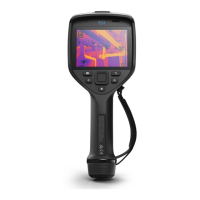26.4 Insulation deficiencies
General
Insulation deficiencies may result from insulation losing volume over the course of
time and thereby not entirely filling the cavity in a frame wall.
An infrared camera allows you to see these insulation deficiencies because they either
have a different heat conduction property than sections with correctly installed insu-
lation, and/or show the area where air is penetrating the frame of the building.
NOTE
When you are inspecting a building, the temperature difference between the inside
and outside should be at least 10°C (18°F). Studs, water pipes, concrete columns,
and similar components may resemble an insulation deficiency in an infrared image.
Minor differences may also occur naturally.
Figure
In the image below, insulation in the roof framing is lacking.. Due to the absence of
insulation, air has forced its way into the roof structure, which thus takes on a different
characteristic appearance in the infrared image.
10739803;a1
82 Publ. No. T559597 Rev. a554 – ENGLISH (EN) – September 27, 2011
26 – Application examples

